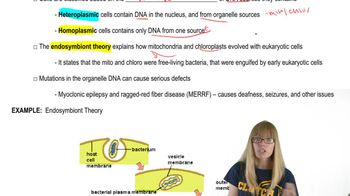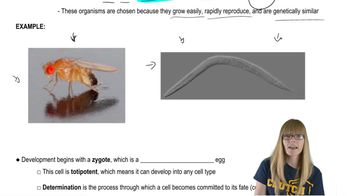Table of contents
- 1. Introduction to Genetics51m
- 2. Mendel's Laws of Inheritance3h 37m
- 3. Extensions to Mendelian Inheritance2h 41m
- 4. Genetic Mapping and Linkage2h 28m
- 5. Genetics of Bacteria and Viruses1h 21m
- 6. Chromosomal Variation1h 48m
- 7. DNA and Chromosome Structure56m
- 8. DNA Replication1h 10m
- 9. Mitosis and Meiosis1h 34m
- 10. Transcription1h 0m
- 11. Translation58m
- 12. Gene Regulation in Prokaryotes1h 19m
- 13. Gene Regulation in Eukaryotes44m
- 14. Genetic Control of Development44m
- 15. Genomes and Genomics1h 50m
- 16. Transposable Elements47m
- 17. Mutation, Repair, and Recombination1h 6m
- 18. Molecular Genetic Tools19m
- 19. Cancer Genetics29m
- 20. Quantitative Genetics1h 26m
- 21. Population Genetics50m
- 22. Evolutionary Genetics29m
3. Extensions to Mendelian Inheritance
Organelle DNA
Problem 18b
Textbook Question
Mutations in mitochondrial DNA appear to be responsible for a number of neurological disorders, including myoclonic epilepsy and ragged-red fiber disease, Leber's hereditary optic neuropathy, and Kearns-Sayre syndrome. In each case, the disease phenotype is expressed when the ratio of mutant to wild-type mitochondria exceeds a threshold peculiar to each disease, but usually in the 60 to 95 percent range.
Given that these are debilitating conditions, why has no cure been developed? Can you suggest a general approach that might be used to treat, or perhaps even cure, these disorders?
 Verified step by step guidance
Verified step by step guidance1
<span>Step 1: Understand the nature of mitochondrial DNA (mtDNA) mutations. Mitochondrial DNA is inherited maternally and is present in multiple copies within each cell. Mutations in mtDNA can lead to a variety of disorders, particularly affecting energy-demanding tissues like the nervous system and muscles.</span>
<span>Step 2: Recognize the challenge of heteroplasmy. Heteroplasmy refers to the presence of both normal (wild-type) and mutant mtDNA within a cell. The expression of a mitochondrial disorder depends on the proportion of mutant mtDNA, which must exceed a certain threshold to manifest the disease phenotype.</span>
<span>Step 3: Consider the difficulty in targeting mtDNA. Unlike nuclear DNA, mtDNA is located in the mitochondria, making it less accessible to traditional gene therapy techniques. Additionally, the high copy number of mtDNA in cells complicates efforts to selectively target and replace mutant copies.</span>
<span>Step 4: Explore potential therapeutic approaches. One approach could involve shifting the balance of heteroplasmy by promoting the replication of wild-type mtDNA or selectively degrading mutant mtDNA. Another strategy might involve using mitochondrial replacement therapy, where defective mitochondria are replaced with healthy ones from a donor.</span>
<span>Step 5: Investigate ongoing research and experimental treatments. Scientists are exploring various methods, such as CRISPR-based gene editing and mitochondrial transfer techniques, to address mitochondrial disorders. These approaches are still in experimental stages but hold promise for future therapies.</span>
Recommended similar problem, with video answer:
 Verified Solution
Verified SolutionThis video solution was recommended by our tutors as helpful for the problem above
Video duration:
1mPlay a video:
Was this helpful?
Key Concepts
Here are the essential concepts you must grasp in order to answer the question correctly.
Mitochondrial DNA and Mutations
Mitochondrial DNA (mtDNA) is distinct from nuclear DNA and is inherited maternally. Mutations in mtDNA can disrupt the normal function of mitochondria, which are crucial for energy production in cells. These mutations can lead to various diseases, particularly affecting tissues with high energy demands, such as the nervous system. Understanding the types and effects of these mutations is essential for addressing mitochondrial disorders.
Recommended video:
Guided course

Organelle DNA Characteristics
Threshold Effect in Mitochondrial Diseases
The threshold effect refers to the phenomenon where a certain proportion of mutant mitochondria must be present for the disease phenotype to manifest. In mitochondrial disorders, this threshold typically ranges from 60% to 95% mutant mitochondria. This concept is critical for understanding why individuals may remain asymptomatic despite carrying mutations, as the ratio of mutant to wild-type mitochondria can vary significantly among individuals.
Recommended video:
Guided course

Maternal Effect
Current Challenges in Developing Treatments
Developing treatments for mitochondrial diseases is challenging due to the complexity of mitochondrial genetics and the role of both nuclear and mitochondrial DNA. Additionally, the heteroplasmy (presence of both mutant and wild-type mtDNA) complicates treatment strategies. Current approaches may include gene therapy, mitochondrial replacement techniques, and pharmacological interventions aimed at improving mitochondrial function, but these are still in experimental stages and face significant scientific and ethical hurdles.
Recommended video:
Guided course

Genetics of Development

 4:11m
4:11mWatch next
Master Organelle DNA Characteristics with a bite sized video explanation from Kylia Goodner
Start learningRelated Videos
Related Practice


